What Is Plr Safety?
Key Takeaway
PLr, or Required Performance Level, is a crucial concept in safety engineering, used to specify the level of risk reduction needed for each safety function of a machine. It determines how reliable the safety function needs to be to ensure adequate protection.
In essence, the performance level (PL) of any safety-related part of a control system must meet or exceed the PLr to be considered adequate for safe operation. This ensures that the safety measures in place are sufficient to protect against the identified risks, providing a systematic approach to maintaining safety standards in industrial settings.
Overview of Performance Level Required (PLr)
The concept of Performance Level Required (PLr) is pivotal in assessing the safety requirements of machinery within industrial settings. PLr quantifies the necessary reliability of safety functions to mitigate risks effectively. This assessment starts with identifying potential hazards associated with machinery operation, evaluating the frequency and exposure to these hazards, and determining the severity of possible injuries. By setting a required performance level, industries can align their safety mechanisms with the operational demands and inherent risks, ensuring worker safety is not compromised.

The Criteria for Determining PLr Safety Levels
Determining the appropriate PLr involves a meticulous process that integrates both qualitative and quantitative risk assessments. Factors such as the machine’s potential for causing harm, the frequency of human interaction with the machine, and the possibility to avoid hazards are carefully analyzed. This evaluation helps in categorizing the necessary safety functions and their reliability to ensure the machine operates within safe limits. The outcome is a well-defined safety requirement that matches the complexity and risk level of the machine functions.
You May Like to Read
Technologies That Enhance PLr Safety
Modern safety technologies significantly bolster the effectiveness of PLr through innovations like enhanced diagnostic capabilities, automated monitoring, and adaptive response systems. These technologies not only detect irregularities that could lead to hazardous situations but also react in real-time to prevent accidents. Integration of artificial intelligence and machine learning further refines the safety measures by predicting potential failures and suggesting preventive actions, thereby elevating the safety standards to new heights.
How PLr Safety is Assessed and Rated
The assessment and rating of PLr involve a comprehensive evaluation against established safety standards, such as ISO 13849 or IEC 62061. This includes tests for reliability, fault tolerance, and the ability to perform safety functions under anticipated conditions. Safety integrity level (SIL) or performance level (PL) ratings are assigned based on the results, which indicate the reliability of the safety-related parts of control systems. These ratings help stakeholders understand the robustness of safety measures implemented.
The Relationship Between PLr Safety and Risk Assessment
PLr is intricately linked to risk assessment, serving as a feedback loop that refines safety measures. Through risk assessment, specific safety requirements are identified and subsequently used to determine the appropriate PLr. This dynamic relationship ensures that safety systems are continually updated to mitigate any changes in operational practices or the introduction of new technologies, thus maintaining a safe working environment.
Conclusion
Understanding and implementing PLr is crucial for maintaining a safe industrial environment. It ensures that all safety measures are effective and reliable, protecting workers from potential hazards associated with machinery operations. The strategic application of PLr not only minimizes the risk of accidents but also enhances machine productivity by preventing downtime caused by unsafe conditions. In essence, PLr is fundamental to achieving a balance between operational efficiency and rigorous safety standards in any industrial setting.
